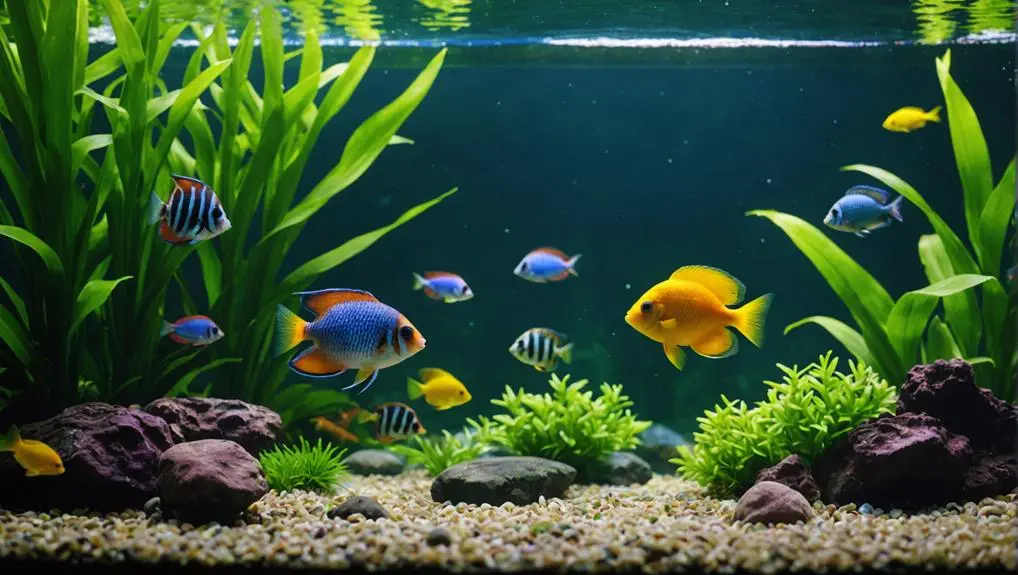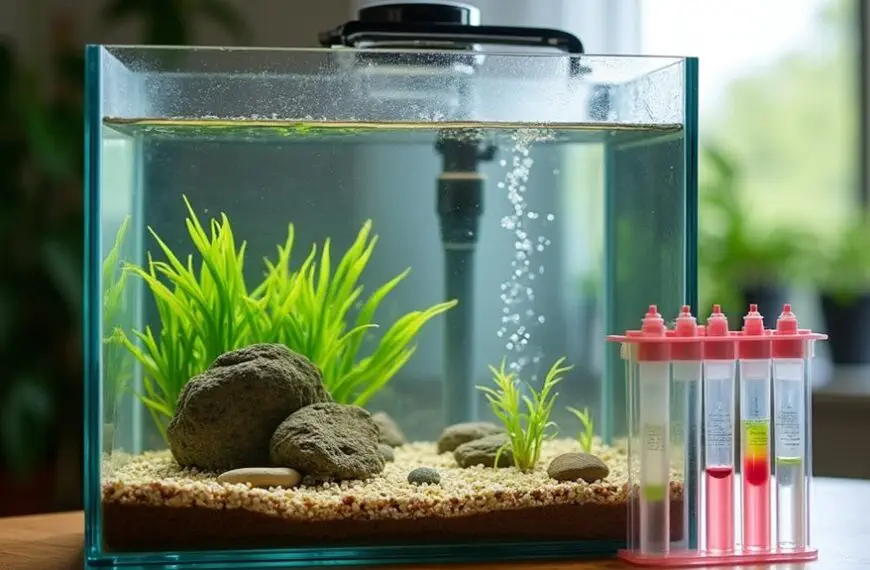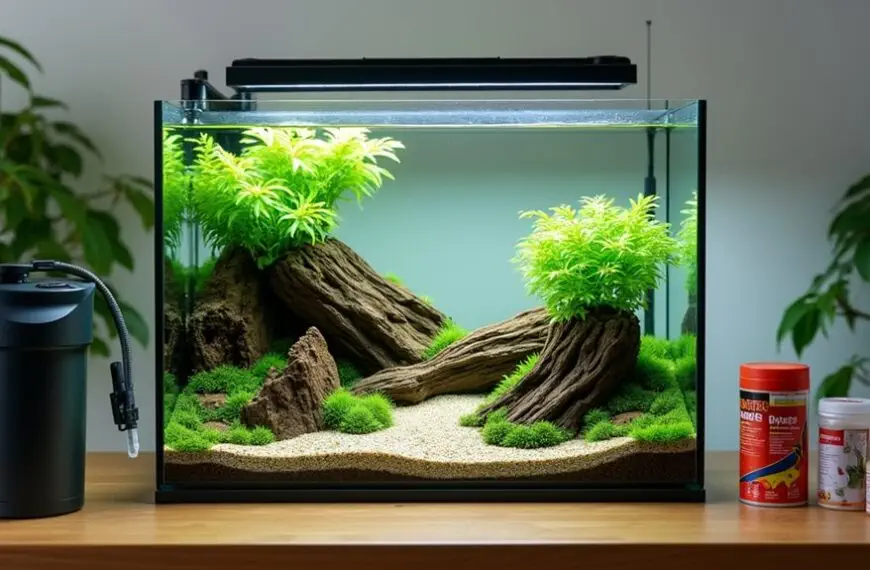Setting up a tropical fish tank can be a rewarding adventure! Start with a 20-gallon tank—bigger is often better for stability. Make sure you've got a quality heater and filter for a clean, warm environment. Don't forget to test your water regularly and do weekly water changes to keep things fresh. Choose peaceful fish that get along; nobody likes a fishy fight! Feed them varied diets and watch for leftovers. Lastly, be patient while your tank cycles; it can take a few months for the magic to happen. Stick around, and you'll discover even more tips to create your underwater paradise!
Contents
- 1 Choosing the Right Tank Size
- 2 Essential Equipment for Your Tank
- 3 Setting Up Water Quality
- 4 Cycling Your Aquarium Properly
- 5 Maintaining a Clean Environment
- 6 Selecting Compatible Fish Species
- 7 Feeding Practices and Schedules
- 8 Acclimation Techniques for New Fish
- 9 Monitoring and Maintaining Tank Health
- 10 Frequently Asked Questions
- 11 Final Thoughts
Choosing the Right Tank Size
When you're setting up your first tropical fish tank, choosing the right size is crucial for both your fish's well-being and your enjoyment. A 20-gallon aquarium is often recommended for beginners. It gives your fish ample swimming space and lets you explore a wider variety of fish species.
Larger tanks, ideally between 70 and 200 liters, are even better since they promote water stability, keeping temperature and pH fluctuations at bay.
Now, don't get too caught up in the old rule of one inch of fish per gallon. You'll want to consider each fish's adult size and swimming habits to get accurate stocking levels. Remember, some fish love to zoom around, while others are more laid-back.
It's also wise to choose a tank with adequate surface area. This helps with oxygen exchange, keeping your fish happy and healthy.
And of course, make sure your tank stand can handle the weight—after all, a fully filled aquarium can weigh around 8 lbs per gallon!
Essential Equipment for Your Tank
What equipment do you need to ensure a thriving tropical fish tank? First, choose a tank size of at least 70-200 liters. This gives your fish plenty of room to swim and helps keep the environment stable.
Next, you'll need a quality heater to maintain water temperature around 25°C (75-80°F). Fish love warm water, and a reliable heater makes sure they stay cozy!
A good filter, like the Oase BioPlus, is essential for removing waste and keeping things clean. Don't forget a safe substrate for planting and non-toxic decorations. Your fish will appreciate a nice, inviting home!
Investing in an effective water conditioner, such as Fluval Aqua Plus, is crucial to eliminate harmful chemicals from tap water. For lighting, a system like the Fluval Plant 3.0 provides the right spectrum for your fish and plants.
Lastly, regular maintenance is key. Check your filter and pump monthly to ensure they're working optimally, keeping your tank an ideal environment for your aquatic friends.
With the right equipment, you're well on your way to creating a beautiful underwater paradise!
Setting Up Water Quality
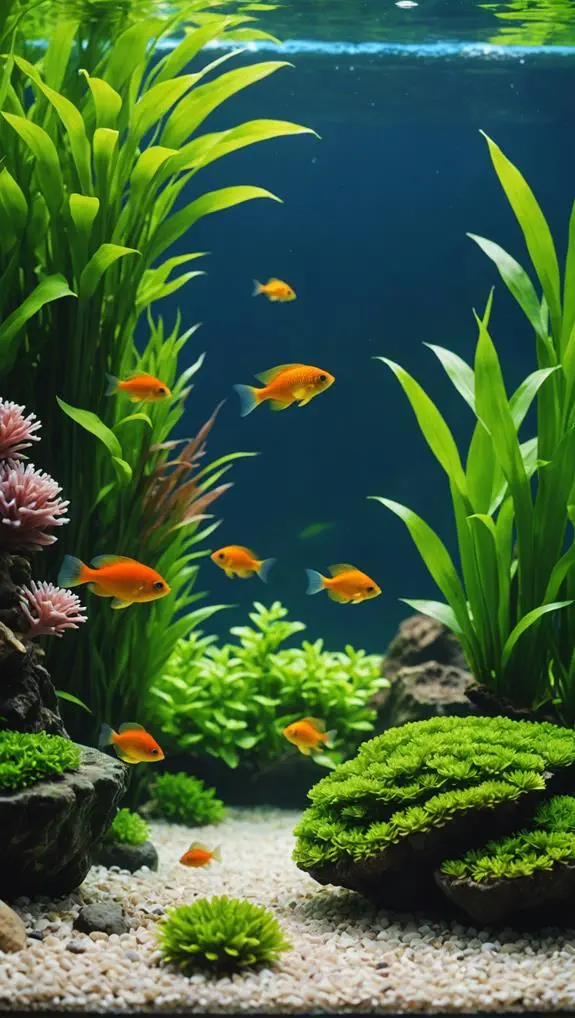
Maintaining high water quality is crucial for the health and happiness of your tropical fish. To achieve this, start by regularly testing the water. Use liquid test kits to check pH, ammonia, nitrite, and nitrate levels. Ideally, keep the pH between 6.8-7.6 and nitrates below 20 ppm. Consistency is key!
You'll want to perform partial water changes of 10-20% each week. This helps remove pollutants while replenishing essential minerals. Just remember to treat new water with a water conditioner to make it safe for fish.
Temperature matters too! Keep your aquarium temperature between 75-80°F (24-27°C), as fluctuations can stress your fish. An accurate thermometer can be your best friend here.
A proper filtration system is essential for maintaining a healthy environment. Aim for a filter that can handle at least double your aquarium volume. This way, you'll support beneficial bacteria that help break down waste.
Lastly, keep an eye out for pesky algae. If it gets out of control, consider cleaning or introducing algae-eating species to help manage it.
With these tips, you're on the right track to creating a happy underwater world!
Cycling Your Aquarium Properly
Cycling your aquarium properly is essential for creating a stable environment for your tropical fish. Think of it as setting up a cozy home for them before they arrive!
This process typically takes 1-3 months, during which beneficial bacteria will establish themselves, converting toxic ammonia and nitrites into safer nitrates. You have two main options for cycling your aquarium: Fishless Cycling, which is safer for your future fish, and Fish-In Cycling, where you monitor the fish daily but risk ammonia poisoning.
No matter which method you choose, regularly testing water parameters is key. Aim for ammonia and nitrite levels at 0 and keep nitrates below 20 ppm to promote fish health.
Utilizing established media from a healthy tank can speed things up, making your tropical fish tank ready more quickly.
Don't forget about water changes! Weekly 50% changes during the cycling period can help maintain water quality and prevent toxic build-up.
This ensures a healthier start for your fish, so they can thrive in their new home. With patience and care, you'll soon have a flourishing aquarium that brings joy to both you and your fish!
Maintaining a Clean Environment
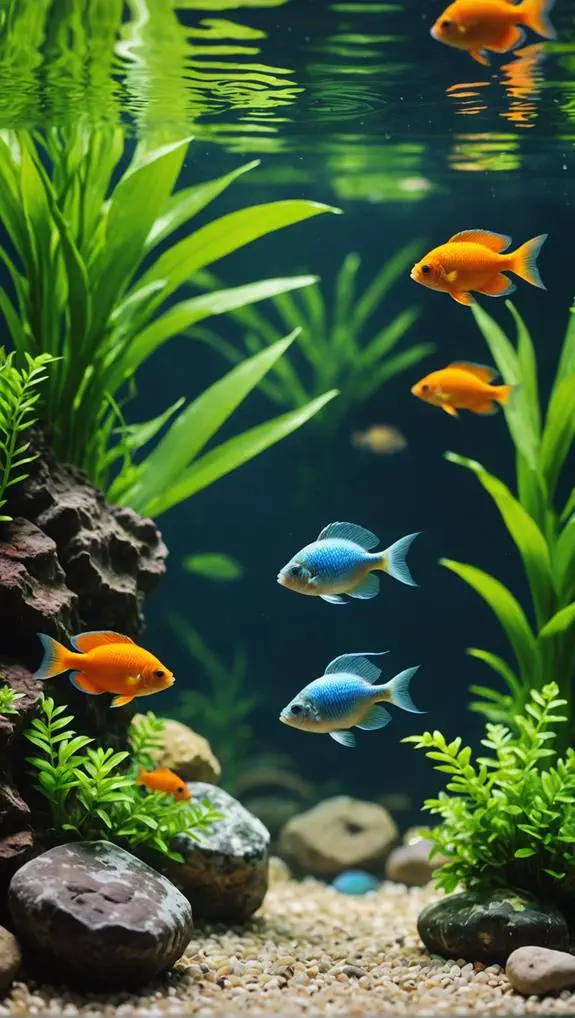
A clean environment is crucial for the health and happiness of your tropical fish.
To achieve this, start with weekly water changes of 10-20%. This simple step helps remove pollutants and maintain stable water parameters, keeping your fish healthy and thriving. Regularly testing your water composition—like pH, ammonia, nitrite, and nitrate levels—allows you to catch any imbalances that could harm your aquatic friends.
Don't forget about the clean aquarium itself! Wipe down the walls and decorations to prevent pesky algae growth. A tidy tank not only looks great but also reduces competition for resources among your fish.
Keep an eye on fish behavior daily; if you notice anything unusual, address it promptly. This vigilance fosters a healthy ecosystem where your fish can flourish.
Lastly, give your water filter and pump some love! Inspect them monthly, and clean or replace the filter media as needed to ensure optimal filtration and water clarity.
With these tank maintenance tips, you're not just caring for fish; you're creating a little underwater paradise where they can swim happily!
Selecting Compatible Fish Species
When you're setting up a tropical fish tank, picking the right fish is crucial for a peaceful community.
You'll want to research which species get along, since some can be a bit territorial or even see their tank mates as a snack—yikes!
Community Tank Compatibility
Creating a harmonious community tank starts with selecting fish species that get along well together.
You'll want to prioritize peaceful and compatible species, like guppies, tetras, and corydoras. These friendly fish help prevent aggression and stress, making your tank a joyful place.
Before you dive in, it's essential to research each species' temperaments and water conditions. Mixing aggressive fish with docile ones can lead to territorial disputes, which nobody wants!
Consider the size and swimming space each fish needs, as overcrowding can spark competition for resources, leading to unwanted drama.
When you introduce new fish, take it slow. Gradually adding them to your community tank allows the established fish to adjust, reducing potential conflicts during acclimation.
Remember, a well-balanced environment is key. Group fish that thrive in similar water conditions—pH, temperature, and hardness—so all your aquatic friends can flourish together.
With a little planning and care, you can create a peaceful underwater world where every fish feels right at home.
Happy fishkeeping!
Species Temperament Assessment
Understanding the temperament of various fish species is crucial for building a peaceful community tank. You definitely want to avoid mixing aggressive species with more peaceful ones, or you might end up with a fishy version of a reality show! Researching individual species temperament helps ensure compatibility, and it's a smart move.
Consider keeping schooling species like tetras and rasboras in groups of six or more. They thrive in numbers, and it reduces stress—think of it as their little fishy support group!
On the flip side, be aware of the territorial nature of species like cichlids. They'll need plenty of space to swim and hiding spots to feel secure.
When assessing compatibility, consider size and environmental needs. Mixing large predatory fish with smaller, vulnerable species is like inviting a lion to a petting zoo—definitely not a good idea!
Use aquarium resources and community forums to tap into the wisdom of experienced aquarists. They can offer valuable insights on successful tank combinations, so don't hesitate to ask for help.
Building a harmonious community tank is rewarding, and with thoughtful choices, you can create a vibrant underwater world!
Feeding Practices and Schedules

Feeding your tropical fish properly is crucial for their health and happiness. You want to ensure that you're giving them a varied diet, including high-quality flakes, pellets, and even some frozen foods. This mix helps keep your fish healthy and happy!
Establish a consistent feeding schedule, ideally 2-3 times a day. Just remember to only feed what they can consume in about two minutes. Overfeeding can lead to uneaten food floating around, which can mess up your water quality—yikes!
Pay attention to your fish's behavior; if they leave food behind, cut back a little. Different species have different needs, too. Omnivorous fish tend to thrive on multiple small feedings, while carnivorous types prefer larger meals less often.
And don't forget to scoop out any uneaten food after feeding. It might seem like a chore, but it's key to keeping your tank clean and your fish thriving.
Acclimation Techniques for New Fish
Introducing new fish to your tropical tank requires careful acclimation to ensure they adjust well to their new environment. You want your new fish to feel at home, right?
Start with the Float Method: float the sealed bag in your aquarium for about 10-15 minutes. This helps equalize the temperature. After that, slowly add small amounts of tank water to the bag over 2-3 cycles.
Alternatively, you can use the Drip Method. Create a drip line to let aquarium water slowly enter a container with your new fish. Adjust the valve to control the flow rate so they can gradually acclimate to your tank's pH and hardness levels. Aim for a total acclimation time of 30 minutes to 2 hours, depending on how sensitive the fish are.
While you're at it, don't forget to monitor your water parameters like temperature and pH throughout the process.
After acclimation, it's best to net the fish into the tank instead of adding the bag water. That way, you avoid introducing any harmful chemicals or pathogens.
Happy fishkeeping!
Monitoring and Maintaining Tank Health
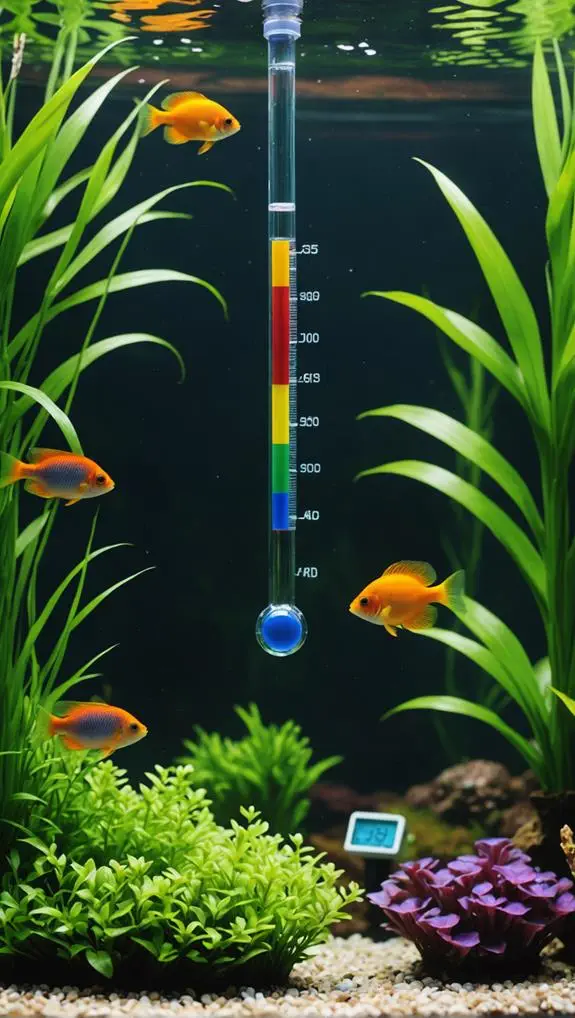
Keeping your tropical fish tank healthy is all about staying on top of water quality and regular maintenance.
You'll want to test your water weekly, checking for things like pH and ammonia, so your fish can swim happily.
Plus, don't forget to schedule those weekly water changes and cleanings, because nobody likes a dirty fish tank—especially not your finned friends!
Water Quality Testing
To ensure a thriving environment for your tropical fish, regularly testing water quality is essential. Start by checking pH levels, ammonia, nitrite, and nitrate levels at least once a week. Ideally, ammonia and nitrite should sit at 0, while nitrate levels should remain below 20 ppm. Keeping an eye on these parameters helps you create a safe haven for your finned friends.
Don't forget about temperature! Maintaining a cozy 25°C (75-80°F) is crucial to prevent stress or illness. It's like giving your fish a warm hug!
To keep things stable, perform partial water changes of 10-20% weekly. Adjust this based on your tank's bioload—after all, some fish are messier than others.
Also, always use high-quality water conditioners to zap harmful chemicals like chlorine before adding tap water. It's the little things that count!
Routine aquarium maintenance should include monitoring for algae growth and checking filter efficiency. A clean tank isn't just pretty; it's safer for your fish.
Regular Maintenance Schedule
A regular maintenance schedule is vital for ensuring the health and happiness of your tropical fish. Start by testing water parameters weekly—check the pH, ammonia, nitrite, and nitrate levels. This helps you maintain the best water quality for the fish in the tank.
You'll also want to perform partial water changes of 10-20% weekly; it's like a refreshing spa day for your aquatic friends!
Keep an eye on fish behavior, too. If you notice any unusual swimming patterns or rapid gill movement, it could indicate something's off in their environment.
Monthly, inspect your filters and pumps for efficiency; clogged filters can cause problems faster than a fish can swim!
Don't forget to clean the aquarium regularly to prevent algae buildup. A full tank cleaning once a month should include substrate vacuuming and rinsing filter media in old tank water—this way, you keep those beneficial bacteria alive and kicking.
Frequently Asked Questions
What Do Tropical Fish Like in Their Tank?
Tropical fish love well-chosen tank mates, stable water temperature, suitable substrate, and effective filtration systems. Offer diverse plant options, adjust light intensity, maintain an adequate aquarium size, and create enriching tank decorations for their happiness.
How Do You Set up a Perfect Tropical Fish Tank?
To set up your perfect tropical fish tank, choose the right tank size, select suitable substrate, ensure proper water temperature, implement a filtration system, and plan lighting, decorations, and plant choices for optimal fish compatibility and maintenance.
How to Keep a Healthy Tropical Fish Tank?
To keep a healthy tropical fish tank, focus on water quality, tank maintenance, filter selection, and temperature control. Ensure compatible fish, appropriate substrates, plant integration, proper feeding schedules, suitable lighting levels, and effective disease prevention techniques.
How Long Do You Leave a Tropical Fish Tank Before Adding Fish?
As you envision your vibrant tank, remember to wait 4-6 weeks during the cycling period. Monitor water quality, maintain a stable temperature, and ensure your filtration system is ready before welcoming your new fish friends.
Final Thoughts
So, as you dive into the colorful world of tropical fish tanks, remember that it's not just about the fish; it's about creating a little slice of underwater paradise. Just like a little mermaid searching for her treasures, you've got to care for each detail in your tank. With the right size, equipment, and fish friends, you'll create a thriving ecosystem. Now, go ahead and make a splash—you're well on your way to fishkeeping success!

